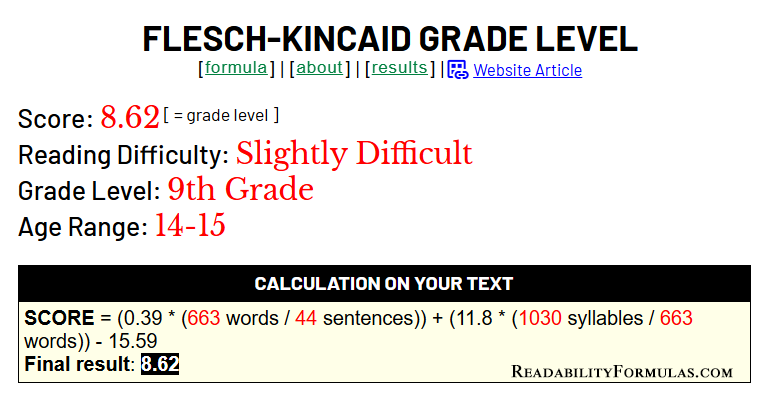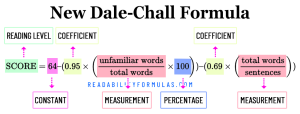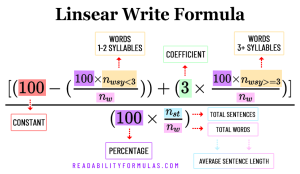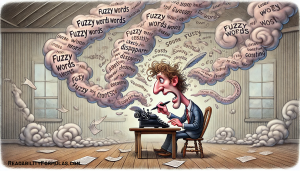
Readability formulas score how easy or difficult a piece of text is to read and understand. They estimate text difficulty based on a number of syntax features, such as word and sentence length, syllable count, or vocabulary difficulty. These formulas output a result equivalent to a grade level (such as “fourth grade” or “12th grade”) or a reading level (easy to hard).
Flesch-Kincaid analyzes text and outputs a score equivalent to a U.S. grade level.
You can choose from several readability formulas, including the Fry Graph, SMOG, Dale-Chall Formula, and Flesch tests (Flesch-Kincaid and Flesch Reading Ease). Because readability formulas vary in purpose and calculation, writers use no more than 1-3 formulas on a text or use an Average Reading Level Consensus.
Studies show that content written at a 6th to 8th-grade reading level improves comprehension by 43% across diverse adult audiences.
(Source: U.S. Department of Education)
The examples below show how words and sentences can affect a text’s readability score. Paragraphs A, B, and C show similar content written at three different grade levels. Can you guess the grade levels? Notice how each example varies in vocabulary and sentence length .
What grade level do you think it is?
Paragraph A
“It makes good sense that premature births and newborn illnesses are decreased by early pregnancy care. doctor is actively involved in testing pregnant woman for induced diabetes host other problems would not be detected patient alone. We know that these problems cause premature births and illness in newborns. It certainly makes sense that earlier detection and of these problems by the doctor results healthier babies.”
Paragraph B
“If you are pregnant or think you may be pregnant, call for an appointment right away. Getting care early in your pregnancy will help have a healthy pregnancy and a healthy baby. Your PCP (or an OB-GYN doctor you choose from your network) will give you certain tests to make sure everything is going well. If there are any problems, it’s good find them early. That way, you have the best chances for a healthy baby.”
Paragraph C
“If you are pregnant or think you might be, go to the doctor as soon as you can. If you start your care early, things will be better for you and your baby. Your own doctor or childbirth doctor from our list will give you a first exam. Testing every month will let you know if all is going well. If there is a certain problem, you’ll know it right away. Then we can do what is needed. Early care is the best way to have a healthy child. Your baby counts on you.”
Answer: Approximate grade levels are:
- A. —12th grade.
- B.—8th grade.
- C.—4th grade.
Be cautious when you use readability formulas.
Readability formulas don’t account for subjective factors that influence reading and comprehension, including:
The Reader’s Active Role:
Readers bring their own knowledge, experiences, and motivations to the text. A highly motivated or knowledgeable reader might find complex material easy to understand, while a less motivated or unfamiliar reader may struggle with simpler text. Factors like reading purpose, background knowledge, and cognitive engagement are ignored in these formulas.
Visual and Structural Elements:
Readability formulas ignore the impact of formatting, font size, color contrast, or visual aids like images, charts, or diagrams, all of which can enhance or hinder comprehension.
Context and Flow:
Readability formulas don’t analyze text cohesion, logical flow, and clear connections between ideas. For example, a text could have short sentences and simple words but still confuse readers if the ideas are disjointed.
Reader’s Emotional and Cultural Context:
Emotional engagement and cultural relevance can influence how easily a reader connects with and understands the text, but formulas don’t capture these subjective elements.
Relying on a grade or reading level score can mislead you into believing that readers can read and understand your materials—when, in fact, they might not.
- Grade level scores for the same text can differ based on your choice of formula and how you use it.
- Grade level scores are less precise than they sound and it is tempting to over-interpret what they mean.
Enforcing a grade level on a text has the potential to do harm. To make text scores at a lower grade level, you could shorten words and sentences. Sometimes this improves ease of reading, but it can also lead to edits that reduce the ease of reading. For example, writers might remove familiar words just because they are long.
Additional Tips:
- Use Sparingly: Readability formulas are useful but know their limits. Do not use them as the sole measure of a text’s quality. While they can guide you to simplify language, they can also guide you to oversimplify or misrepresent its accessibility.
- Your Audience: Tailor your language and sentence complexity to your intended audience. If you are writing for experts in a field, higher-level vocabulary and complex sentences may be perfect. For a general audience, simpler language and shorter sentences can make the content more accessible.
- Flow and Cohesion: Ensure your text flows smoothly from one idea to the next. Transitional phrases and a logical structure can help with this. Even when simplifying language, maintain the natural flow of information.
- Enhance Clarity: Clarity is crucial. Use specific, concrete language and define any technical terms. Avoid jargon unless it is common knowledge for your readers.
- Engage the Reader: Use examples, anecdotes, or stories to illustrate points and help readers understand complex information.
- Edit for Conciseness: Remove unnecessary words and redundancies. Be direct, but don’t sacrifice details.
- Plain English: Learn the rules of Plain English writing to write as clear and concise as the pros.
- Solicit Feedback: Before finalizing your text, ask others for feedback. They can provide insights into how your text reads and whether the content is clear and engaging.
- Professional Help: Consider using professional editing services or software that can provide insights beyond what readability formulas offer. Use the free Robert Gunning Editor to edit your text for readability.
—END—
Long, David. “A Quick Overview of Using Readability Formulas.” ReadabilityFormulas.com, 13 Jan. 2025, https://readabilityformulas.com/an-overview-of-using-readability-formulas/.








